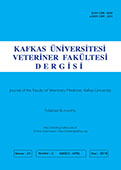
This journal is licensed under a Creative Commons Attribution-NonCommercial 4.0 International License
Kafkas Üniversitesi Veteriner Fakültesi Dergisi
2018 , Vol 24 , Issue 2
Antibiotic Resistance Gene Profiles of Staphylococcus aureus Isolated From Foods of Animal Origin
1Erciyes University, Faculty of Veterinary Medicine, Department of Veterinary Public Health, TR-38039 Kayseri - TURKEY2Erciyes University, Faculty of Veterinary Medicine, Department of Food Hygiene and Technology, TR-38039 Kayseri - TURKEY
3Omer Halisdemir University, Bor Vocational School, Department of Food Processing, Dairy Products and Technology, TR-51700 Nigde - TURKEY
4Erciyes University, Faculty of Medicine, Department of Medical Microbiology, TR-38039 Kayseri - TURKEY DOI : 10.9775/kvfd.2017.18772 In this study, the investigation of the antibiotic resistance gene profiles of Staphylococcus aureus isolates from foods of animal origin was aimed. Totally, 95 S. aureus strains, obtained during a period between 2009 and 2012, from culture collection of the Food Hygiene and Technology Laboratory, were examined. The isolates were confirmed by phenotypic tests and PCR. The antibiotic susceptibilities of the isolates were analyzed by disc diffusion method and the minimal inhibition concentrations of the antibiotics were determined by E test. PCR were also utilized for determining the presence of resistance genes including blaZ, ermA, ermC, tetK, tetM, mecA, VanA, VanB, VatA, VatB and aacA-aphD. Resistance to penicillin, tetracycline, vancomycin, erythromycin, cefoxitin, gentamycin and quinupristin-dalfopristin were evident as 81.1%, 28.4%, 18.9 % 17.9%, 9.4%, 9.4% and 3.2% respectively. E test results were compatible with the disc diffusion method. Multidrug resistance was observed from 29.5% of S. aureus isolates. Positive compatibility was observed between conventional methods and PCR for the resistance of the isolates, except for vancomycin. In addition, all of the tested isolates found to include a resistance gene for at least one antibiotic. In conclusion, more efficient interventions must be followed to control the redundant use of antibiotics in veterinary practice. Furthermore, appropriate control measures are needed to be implemented to reduce contamination and the spread of multiresistant S. aureus strains. Keywords : Antibiotic resistance, Animal origin foods, Multidrug resistance, Resistance genes, Staphylococcus aureus










